What Features are Worth it? Refining Your App Ideation and Scope
When solving a problem, it’s tempting to want to solve every problem. Replacing your car battery? Might as well change the washer fluid. Have a routine check-up with your doctor? Might as well get that flu shot.
While it’s pragmatic to perform routine maintenance on your car, addressing tangential pain points when designing your app can bloat your budget, muddle development, and reduce your app’s user experience. Before deciding what features your app should use, figure out the main pain point you want your app to address.
“I always ask my clients to describe what their app does in two sentences,” said Nick Jones, CEO of NS804, a Richmond, VA based app developer. “If they can’t do that, I know we need to work together to create a concrete, straightforward idea.”
The key to successful development, and in turn, a successful app, is to identify your primary pain point, and then focus on solving that, and only that. All other solutions will stem from your original pain point. It’s like writing a thesis statement – your overall idea needs to be summed up in a few sentences – later, you can get into the details.
“Do your one thing right,” said Jones. “and do it well.”
So, you’ve done your market research, and have identified your main pain point. How do you implement your findings into a successful set of features? Are there certain app features that will provide the functionality your users need at less cost than when compared to another? What even is a feature?
First, let’s go over just what an app’s features entail. Widely used features are as follows:
- Mapping/GPS/Navigation
- Social Sharing
- Back End Management / Reporting
- Game Center
- Push Notification
- Augmented Reality
- Virtual Reality
- Real Time Updating
- Third Party Tool Integration (API)
- Graphics
The more features your app includes, the more time your app spends in development, and the more money you will inevitably spend. Out of this list of features, graphics (including AR and VR) and back end integration are the most time-consuming and expensive features to include in your app.
Keep in mind that certain features can be used, but in a sparing manner. Your app might need a back end to manage data, but it might be manageable without website integration. Your app may need to use graphics to convey ideas to users, but icons might suffice instead of 3D graphics. Find ways to trim the fat from your app’s features, and in turn reduce your budget.
Features are the core of your app, and they include everything from simple fields for users to select, to massive back end infrastructure to manage cloud data storage for millions of users. There’s a wide range to choose from, so make sure you choose wisely.
How do I implement my findings from my market research into a successful set of features?

Let’s say you run a farmer’s co-op, and based on market research, you want to offer your customers an easy way to select their choice of produce to be delivered each week.
That’s all you should focus on for now; providing your users with a simple interface for selecting your currently offered produce, and fields for inputing their delivery address and contact data. To achieve this, the only features your app would need to function are:
- Simple graphical fields for selecting produce
- Simple fields to input user address and contact data
- Back end management for storing and accessing a user’s address and contact data
Believe it or not, that’s really all your app needs to complete your goal. Adding quality of life features – such as a produce rating system used to give customers product suggestions based on food they like – can be added in the future.
Your delivery drivers can input delivery addresses directly into their own phone’s navigation system, so there’s no need to implement navigation in your app. Need to contact a customer? You can use the contact data provided to call or text. In the future, internal app messaging might be something to consider, but you’re not making a messaging service. Don’t be afraid to rely on other apps’ functionality – your users aren’t downloading your co-op delivery app to check the weather.
The more features your app has, the more time is needed to test and debug. When you focus on solving one problem, you reduce your development and testing time, which saves you a lot of money. The less features your app implements, especially at launch, the more robust its user experience will be, as new users will not only be introduced to a simple, easy to understand UI, they also won’t be confronted with as many bugs (or optimally, none at all).
First impressions are important, and it’s no different for your app. If a user downloads your app, and finds they are inundated with various options, numerous fields, and a lengthy learning process, they’re much less likely to continue using your app. Keep in mind that your app most likely isn’t the only one on their phone, so don’t try to do everything.
Another benefit to focusing on solving one pain point is smaller file size. Apps take up space just like any program, and 1 in 6 users delete one app per week to free up storage space. If your app isn’t taking up too much space, it’s less likely to be deleted to make room for another app.
Your app only has to do one thing, but it has to do that thing better than anyone else.
How do I know I’m providing my users with enough features to satisfy them?

After solving your initial pain point, this question is solved by listening to user feedback.
User reviews and feedback are fantastic channels to understand your user’s mindsets. This direct-from-customer research is a goldmine for you; use the reviews and feedback to develop features that improve your app’s user experience and functionality.
When you listen to your users’ requests, you not only develop your app based upon free market research, you strengthen your relationship with your user base. Your users requested push notifications to alert them when your co-op has delivered produce to their door? Do that. It’s a tangental solution, but it still circles back to the app’s main pain point – hassle-free produce delivery. If a user requests a game to keep them occupied while they wait for their delivery, don’t do that. It’s a simple example, but some user requests can be off-track from the main pain point your app solves. Learn to distinguish the bad from the good.
Here’s a litmus test for determining a good feature from a bad one; if the extra feature provides a more complete solution to, or enhances the user experience when solving your main pain point, it’s good. If it doesn’t directly relate to your main pain point, you can decide whether or not it’s truly needed. There’s no definite answer when determining if a feature is bad, but it is easy to figure out if it’s the right fit for your app.
It’s almost like writing a novel. Does your newest chapter fit within the story’s theme? Does the dialogue progress the plot? It works very similarly with app creation – if a feature expounds upon the central solution your app provides, it’s most likely a useful feature. If you’re finding it hard to justify why a character in your story wears flip-flops in the winter, it might not be integral to your plot. In the same vein, if a feature isn’t easily justifiable when held up to your app’s main pain point, it might be better to forgo it.
It’s always better to pick a manageable number of features to focus on – and to execute those features as best as possible – than it is to cast a wide net in an attempt to catch users with multiple functionalities. Venmo, for example, does one thing – money transfers – and it does them well. The average smartphone has 35 apps installed on it – you’re not competing to provide the answers to every problem your user has – you’re focused on providing the optimal solution to one problem out of those 35.
When you provide your users with an easy-to-use app that solves a specific pain point in their lives, they won’t mind if your co-op produce delivery app doesn’t provide real-time map updates, as long as they receive their delivery at the scheduled time and date. Build your foundation first – then add the decorations.
Measure twice, cut once

It’s an old adage, but it rings true. Before taking any steps in developing your app, identify the pain point you want to solve in your target audiences’ lives. Then research that pain point; How many people does this effect? How do they handle this problem currently? What are they asking for? How can you capitalize on this need? What are the most efficient ways to accomplish this?
The first webcam was used by programmers to livestream a coffee pot, so they wouldn’t waste a trip to fill up their mug; it solved their individual pain point, but it didn’t solve the true need millions of other users had. Before executing an idea, ask yourself; is this the root, or a branch?
When you have a solid foundation, and a main focus, build your app around that and only that. If there’s another pain point you discover that isn’t in line with the solution your app is designed to provide, make another. That’s another revenue stream for you.
Do your one thing, and do it well.
Interested in learning more about efficient development techniques? Check out our Minimum Viable Product page.








Leave a Reply
Want to join the discussion?Feel free to contribute!